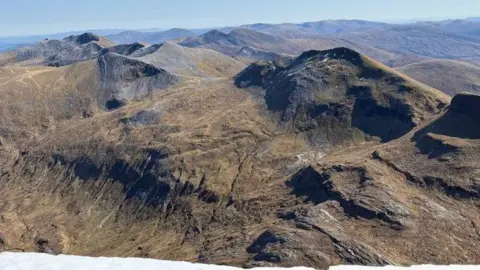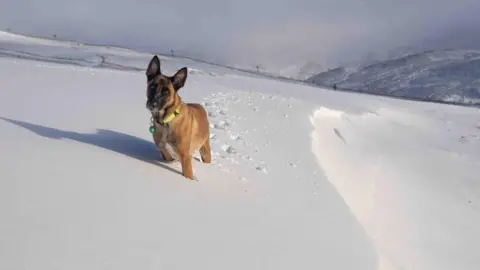Fewest avalanches recorded in almost 40 years
 SAIS Lochaber
SAIS LochaberScotland's latest avalanche season has been wound up after recording the lowest number of snow slides in its almost 40-year history.
Six mountain areas - Lochaber, Glen Coe, Creag Meagaidh, Torridon and Northern and Southern Cairngorms - are monitored for avalanche risk from between mid-December to mid-April.
The Scottish Avalanche Information Service (SAIS) has posted a provisional figure of 42 for the season, with its team describing snow conditions this winter as "lean".
SAIS recorded 172 avalanches last season. Its highest recorded number, 350, was reported in 2013-14.
Co-ordinator Mark Diggins told BBC Scotland News in February that for the first time in nearly 20 years there had been periods during the latest season when SAIS had issued no daily avalanche hazard reports because snow was so scarce.
SAIS' Creag Meagaidh forecaster said anecdotally it had been the "leanest" season for snow for the 1,130m (3,707ft) mountain and surrounding area in more than 30 years.
Only 13 recorded avalanches were recorded compared to 50 in 2023-24.
There were still occasions over this winter when people were caught out.
In February, volunteer mountain rescuers went to the aid of climbers carried off by avalanches in Coire an t-Sneachda - Coire of the Snow - in the Northern Cairngorms.
Two mountaineers were injured after an overhanging ledge of snow - called a cornice - collapsed, resulting in an avalanche.
Three climbers were later caught up in an avalanche triggered by human activity.
 SAIS Southern Cairngorms
SAIS Southern CairngormsSAIS said across Scotland's highest mountains there remained isolated areas of snow above 1,000m (3,281ft), on mostly north to east facing slopes, where climbers could slip and fall if not careful.
SAIS was set up in 1988 and has grown from covering a couple of locations to six.
It covers the UK's highest mountains, including Ben Nevis in Lochaber and Ben Macdui in the Cairngorms.
SAIS forecasts are used by hillwalkers, climbers and snow sports enthusiasts to plan their visits to the hills.
Mountain rescue teams also consult the forecasts when on callouts.
